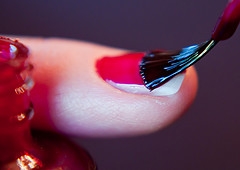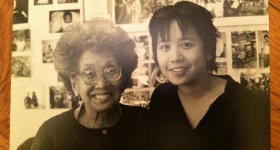Photo courtesy of Asian Law Caucus
Thu Quach is a research scientist at the Cancer
Prevention Institute of California and one of the few people studying nail salon workers and the health hazards they face. (To learn more about the issue, read my story, "Mani-Pedis Go
Green").
Quach's mother, who worked in salons cutting hair and also doing nails, passed away from cancer in 2005. I sat down with Quach at her office in
Berkeley, CA to talk about her mother's influence on her work, what's being doing to ensure the safety of workers and customers, and what customers can do to help shift salons to safer environments. Quach's workplace is one member of the CA Healthy Nail Salon
Collaborative, a collaboration of more than 30 organizations.
Your mom worked as a cosmetologist. Can you talk about her influence on you?
My mom, and this true of a lot of Vietnamese families, we
always have someone who works in the nail salon industry or hair salons. So mom
was a hairdresser in Vietnam and came here. She didn’t work for a number of
years but decided to go back and get licensed as a cosmetologist. She passed (the tests), and had
worked in many different salons.
When we grew up,
she did all our hair and everything. I remember we’d get our hair dyed or permed and my dad
and brother would come home and say, "Oh, it really stinks" because the smells
really stays. It’s really interesting because both my parents are in occupations
that deal with a lot of chemicals. My dad is an auto mechanic and my mom is a
hairdresser.
At the time, it
just felt like, okay, that’s just what they do and as I went into public health
and learned a lot more about this, I got into the idea of environmental justice
and occupational rights. And I had, for a long time, thought, well, what are
the implications when you do go into a nail salon or hair salon and work in
these?
And then, my mom, we found out, was diagnosed with cancer.
The first thought was always,
well, what about the chemical warfare? Well, who
knows, it’s still a ways to know what all that Agent Orange meant to this
population. And the second thought that came up was her occupation, and whether
all of these things combined really caused her to develop abnormal growing
cells, which are basically what cancer is.
And it’s been interesting, because I tell this story that I
went and got my PhD before she actually passed away. And part of it
is because she said, well, I think you should go and check with the state,
because there’s a licensee file [Quach's research focused on the link between nail salon workers and cancer rates]. So in many ways, I talk about my dissertation
being her idea.
What are some of the findings from your more recent research?
What we did was we recruited 20 salons and 80 female workers
from mostly the East Bay (with community partner, Asian Health Services). And
we asked them to wear a small personal air monitor which is
supposed to capture the air around their breathing zone.
What we found is that the toluene (a chemical linked to birth defects and other reproductive harm) levels were higher than
what was recommended for indoor air (according to CAL EPA levels). It indicated why nail salon workers are
complaining about so many problems, because their air is just not good.
For the stationary monitors, we tested for Methyl
Methacrylate (MMA). MMA was found in all three salons we tested. MMA is a compound that’s
been banned since 1974 in nail products.

Photo © 2010 J. Ronald Lee
So chemicals that have been banned for decades are still showing up in salons. What are some things that can be done about the health hazards in nail salons?
We (the California Healthy Nail Salon Collaborative, Women's Voices for the Earth and the National Asian Pacific American Women's Forum) got together to push for the re-introduction of the
National Safe Cosmetics Bill,
which is a national bill that really pushes the cosmetic manufacturers to
report the ingredients that are being used, to ban certain compounds and just
really have more transparency and accountability when it comes to ingredients
included in cosmetics products. We were there to have a congressional briefing
and I was one of the speakers. We also brought along nail salons workers and an
African American hair salon worker to talk about why it’s really important to
push through this bill on the national level.
A lot of this comes after everything with the Brazilian Blowout.
The Brazilian Blowout is a type of hair straightening product and it’s being
used in hair salons. It was advertised as not having any
formaldehyde, which causes cancer. However, the Department of Public Health as
well as other regulatory agencies were getting calls from both consumers as
well as salon workers, saying, "This stuff smells really nasty and I’m getting
really concerning reactions to it." So when they went in and monitored, they
found that not only did it have formaldehyde, but the measured levels were way
above what any occupational levels should be.
This brand
actually advertises and they still continue to advertise some of their products
as, "This is formaldehyde-free." And no one’s really checking it. And this
really underscores the need for us to have better regulation of the cosmetic
industry.
Are there other things that can be done, such as using safer nail polishes?
One thing that we’re wrestling with is, products
that don’t have these three toxic compounds then get seen as safer. But then
they still contain other compounds that may be. So it’s hard for us to know exactly what
is safe. It goes back to this chemical-by-chemical approach that we’re still
figuring that out.
I think at some point, we’re hopefully working with
regulatory agencies to maybe do some spot checks on some of these. What we learned
from the Brazilian Blowout is that they were claiming it’s formaldehyde-free,
when it obviously wasn’t.
The CA Healthy Nail Salon Collaborative was also able to get the San Francisco Nail Salon Recognition Ordinance
passed. What this
ordinance says is, salons that use nail polishes that don’t containt the toxic
trio actually get certified. It’s an incentivizing
program rather than a penalty program. Sort of like the restaurants and
the A, B, and C. San Francisco was the first to pass the ordinance and we’re working
with them to implement it, and we’re hoping to expand to the rest of the state
and down the line, even nationally, if it works out well.
What is the consumer's role?
If you can even educate consumers and say, well, we may have
to charge you a dollar more (using safer polishes), but the implications are you’re
not putting something that has dangerous chemicals on you, and the workers
aren’t exposed when they use it. (The
California Healthy Nail Salon Collaborative has a list of toxic-trio free nail
polishes here --
click on “Toxic Trio Wallet Card").
Sometimes, customers bring in their own nail polish. What I’ve noticed is how much influence the customer has.
I’ve heard this from salon workers: if the customer asks for this, then we can
respond. If the customers don’t care and it’s all about the price, then that
will be the driving force for what products are used. Whatever your role is in this picture, are you the children of a
worker, or are you a consumer, you really can add to the picture. We all have a
role in all of this.
What’s been nice about focusing on this workforce, and I would say that it
applies to any workforce, whether it auto mechanics or dry cleaners, there’s
always that feeling that, sometimes our parents couldn’t say these things. The
second generation raises these issues to really highlight the needs. We’re
talking about a really underserved, understudied population. And the need
really falls upon the children of immigrants to raise these issues.
This is an edited version of the interview.










Comments